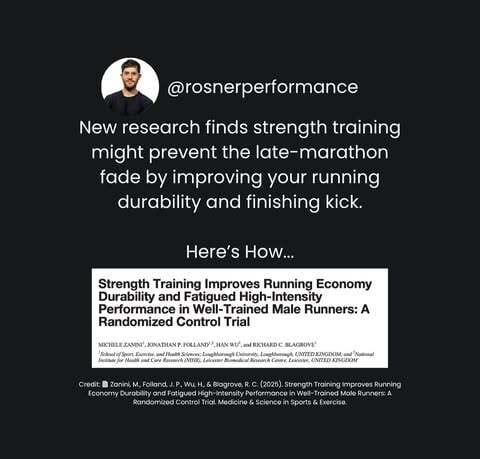The Most Underrated Nutrient in Your Diet?
Estimated read time: 3.36 minutes (roughly the time it takes Augie to sniff out the best bone snack—he has standards). 😉
Hey Performance Nerds! Jonah here. 🤓
Most athletes track protein. Few track this (and it might be just as important).
Fiber doesn’t get much attention, but it plays a major role in nutrient absorption, digestion, and overall performance.
This week’s guest post comes from my good friend Dan Churchill, performance chef to elite athletes, hybrid competitor himself, and a master of simple, effective fueling.
Dan’s breaking down exactly why fiber deserves a spot on your performance radar and how to get more of it without wrecking your gut.
In this post, Dan covers:
Why fiber matters for performance
The two types of fiber and what they do
How much fiber you actually need (hint: more than you think)
Easy ways to add more fiber to your meals
👉 Want more simple, science-backed nutrition tips from Dan?
Subscribe to his weekly newsletter here: danchurchill.com/legendary
Let’s get nerdy. 🧪👇
🧬 Performance Sponsor:
🚀 Train Harder. Recover Smarter.
SiS—the same science-backed fuel trusted by Olympic marathoners—is now sponsoring Marathon Science.
From hydration mixes to recovery tools, every product is backed by real performance data and built for serious athletes like you.


Why Fiber Deserves the Spotlight 🧪
G’day legends—Dan here.
I know everyone’s focused on macros and protein shakes. But performance isn't just about what you eat—it’s about what your body absorbs.
Fiber plays a critical role in digestion, gut health, and nutrient absorption. If you're not thinking about fiber, you’re not fueling completely.
What Is Dietary Fiber? 🌾
Fiber is a type of carbohydrate found in plant-based foods—but unlike other carbs, your body doesn’t digest it.
Instead, it moves through your digestive system doing essential behind-the-scenes work.
There are two types:
✅ Soluble fiber
Dissolves in water and forms a gel-like substance
Slows digestion, helps control blood sugar, and lowers cholesterol
🥣 Found in oats, chia seeds, legumes, and apples
✅ Insoluble fiber
Doesn’t dissolve in water and adds bulk to your stool
Supports regularity and digestive speed
🥦 Found in veggies, whole grains, nuts, and fruit skins
Most people think of fiber as just a gut “cleanser.” But its most powerful effects happen deep in your microbiome.
Here’s how it works:
💥 Feeds your gut bacteria
Fiber is the primary fuel source for the beneficial microbes in your gut.
🔬 Produces performance-supporting compounds
As those microbes ferment fiber, they create short-chain fatty acids (SCFAs)—which reduce inflammation and support endurance, recovery, and metabolic health.
🧱 Strengthens your gut lining
SCFAs help reinforce your intestinal barrier, improving nutrient absorption and protecting against GI issues.
⚙️ Boosts full-system function
A healthier gut means better digestion, better fueling, and more consistent performance.
High-Performance Fiber Foods 🥑
Here are some of my go-to fiber-packed options:
Food | Amount | Fiber |
|---|---|---|
Chia seeds | 2 tbsp | ~10g |
Cooked lentils | ½ cup | ~8g |
Avocado | ½ | ~7g |
Oats | 1 cup | ~10g |
Almonds | ⅔ cup | ~8–9g |
Raspberries | 1 cup | ~6.5g |
Broccoli (cooked) | 1 cup | ~3.3g |
Apple (with skin) | 1 medium | ~4.4g |
Sweet potato (with skin) | ½ medium | ~3.8g |
These foods show up constantly in my meals — like my Power Bowl, which clocks in around 17g of fiber per serving.
How Much Fiber Do You Really Need? 📊
General guidelines:
Women: ~24g/day
Men: ~38g/day
For active folks and endurance athletes?
Aim for 30–34g/day for optimal performance.
⚠️ Start slow if you're not used to high-fiber eating—and hydrate to avoid bloating or GI issues.
How to Boost Your Fiber Intake 💡
Simple strategies:
Add chia or flax to oats and smoothies
Keep fruit skins on
Choose whole grains over refined
Load veggies into every meal
Snack on almonds or cashews
Try legume-based pasta (bonus: more fiber and protein)
🚫 Go Slow with Fiber Increases. Jumping from low to high fiber overnight? That’s a fast track to bloating and GI distress.
Instead, aim for a gradual ramp-up over 4–6 weeks.
➡️ Add just 2–4g of fiber per day each week
➡️ Always increase your water intake as you go—hydration keeps things moving smoothly
Bonus Tips for Runners & Hybrid Athletes 🏃♂️💥
⏱️ Time Your Fiber for Performance
Before workouts: Avoid high-fiber foods in the 1–2 hours before training
Before races: Give yourself more buffer—skip fiber in the 3–4 hours before start time
Best times for fiber: Earlier in the day or after your workout, when it won’t interfere with digestion
Hydration is key: Think of fiber like cement—it needs water to stay functional.
Track it: Just like macros, log your fiber for a week. You might be surprised how low it actually is.

Jonah’s Wrap-Up 🧠
Dan crushed it with the practical, gut-friendly strategies. Now here’s my quick breakdown of the science behind why fiber deserves a spot in your performance plan.
🧪 Key Takeaways from the Research:
Fiber is the missing link
Most athlete nutrition plans focus on carbs and protein—fiber is often overlooked.
It fuels your gut microbiome
Certain fibers (MACs) feed gut bacteria, which produce SCFAs that support digestion, recovery, and gut health.
Target ~30g/day
Work up to ~30g daily, including ~2g of beta-glucan from oats or barley for added performance benefits.
Ramp up + time it right
Increase fiber slowly over 4–6 weeks.
➤ Avoid fiber 1–2 hours before training
➤ Skip it 3–4 hours before races
Want more simple, science-backed nutrition tips that actually taste good?
Dan shares gut-friendly recipes, performance strategies, and zero-fluff fueling advice every week.
👉 Subscribe to his newsletter here and start eating like an athlete—without overthinking it.

🚨 New Research Shows Strength Training May Prevent Your Marathon Bonk
Did you miss my post about New Research Shows Strength Training May Prevent Your Marathon Bonk? You can find it below!
I won’t lie. These posts take me a while to make. If you find it helpful, share it on your story or with a friend. It helps me a ton!

Are You a True Running Nerd? Prove it.. 🧐
Welcome to the prove you’re a nerd section. Each week, I ask a question about a common running science myth.
Answer correctly, and you’ll be entered into a weekly raffle to win a package of Jonah’s favorite supplements.
Which muscle does the majority of the work in distance running—even at speeds up to a 3:50 mile pace? 🧠

💥 Last Week’s Results: The Buffer Battle! 🧪🔥
Boom, nerd squad, you nailed this one like a well-timed interval rep. 🧠💣
The right answer?
C. Sodium bicarbonate ✅
This powerhouse supplement helps buffer hydrogen ions, aka the acidic byproducts that build up when you're going hard above threshold. That burning sensation in your quads during VO2 max work? That’s hydrogen ion overload, not lactate. Sodium bicarb helps delay that fatigue by keeping your muscle pH in check.
But not everyone was on the buffer bandwagon…
Vote Breakdown:
⬜️ A. Creatine monohydrate – 18 votes
⬜️ B. Electrolytes – 16 votes
🟩 C. Sodium bicarbonate – 186 votes ✅
⬜️ D. Beta-alanine – 8 votes
Myth check:
Electrolytes help with hydration, not acid buffering. Creatine helps with short bursts (think heavy lifting or 100m sprints), not longer intervals. Beta-alanine? It does buffer acidity—but works best for sustained 1–4 minute efforts, like 800m races.
Sodium bicarb is the best for repeated, high-intensity bursts like intervals or HYROX stations.

Nerdy Finds of the Week 📚🧑🔬
This section includes my favorite research, podcasts or books about running/lifting science.
Paper: How much running is too much? Identifying high-risk running sessions in a 5200-person cohort study
🔬 Core Finding
Going more than 10% longer than your longest run might raise injury risk
📊 Key Research Points
1 in 3 runners got injured over 18 months
+10% distance ➔ 64% higher injury risk
+30% ➔ 52% higher risk
Doubling distance ➔ 128% higher risk
Week-to-week mileage changes didn’t predict injury
Big weekly jumps (ACWR) linked to lower injury risk
Most injuries happened 1–2 days after the long run
Runners had no warning signs before injury
Even 1–10% increases showed slight risk bump
🛠️ Practical Applications
⚡ Single-run spikes >10% ➔ Higher injury risk
⏱️ Keep long-run increases gradual ➔ Avoid overload
🚫 Weekly mileage or ACWR ➔ Not reliable for injury prevention
⚡ Base next run on your longest run in past 30 days
⏱️ Back-to-back +10% runs ➔ Risk adds up fast
🎯 Bottom Line
Injury risk isn’t just about mileage—it’s complex and personal
This study shows the 10% rule for a single run might still matter, but it’s not a magic number
ACWR may be outdated for runners—it missed injury spikes in this study
Best move? Smart, slow progression based on how you recover—not just your watch data

Don’t forget: You + Science = AWESOMENESS 😎
Yours in science,
Jonah
P.S. - We have a crew of 17,280+ nerds here who are running FAST using science.
Did you need running science advice or tips? 🏃♀️💨🧪
Reply with your question, Augie and I (pictured below) will get back to you with science-backed tips!


Enjoy the newsletter? Please forward to a pal. It only takes 18 seconds. Making this one took 11.23 hours.
Please email me directly if you’re interested in references for this week!


